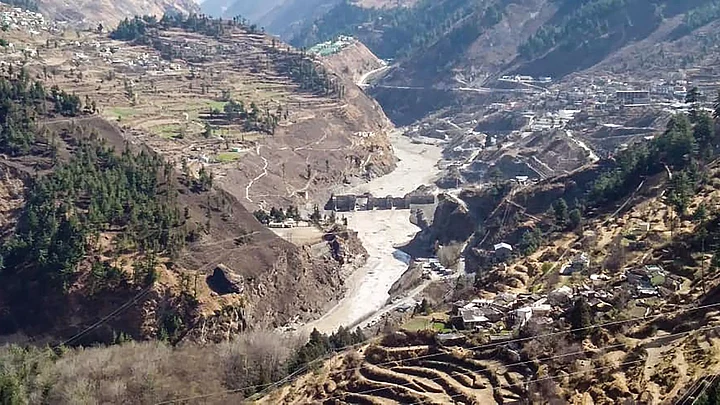It is not yet clear whether there is a link between the devastation in Chamoli, Uttarakhand on Sunday, 7 February, and the long line of hydro-electric power projects in the state.
However, as the fallout from the disaster continues, it is important to note that questions over the impact of these projects and their connection to such disasters have been raised in the past – including in the Supreme Court of India and the Uttarakhand High Court.
Moreover, not only have the courts appointed committees to examine these questions, they have also imposed stays and moratoriums on hydel projects and dams in the state.
Here’s what has happened in the courts thus far and how the government has responded.
CASES IN SUPREME COURT, 2013 ONWARDS
Following the Kedarnath cloudburst in 2013, which led to the deaths of over 5,000 people, the Supreme Court took suo motu cognizance of the situation and decided to get expert views on the possible role of hydel projects in the region.
On 13 August 2013, the apex court imposed a moratorium on any new hydro-electrical power projects in Uttarakhand, and also directed the Union Ministry of Environment and Forests to set up an expert committee to assess the impact of such projects on environment degradation.
Dr Ravi Chopra, director of the People’s Science Institute headed this committee, which submitted a report to the Centre. The expert report raised concerns about the suitability of hydel projects in areas at an altitude of 2,200 metres above sea level and higher.
Speaking to Hindustan Times on Sunday, Chopra said:
“We had said in our report that the region above 2,000 metres in Uttarakhand in the valleys is not suited for hydroelectric projects...when glaciers recede, there can be a lot of debris and moraines that flow down. Huge boulders also come along. There appears to have been an avalanche and a glacial lake outburst in the Rishi Ganga valley, and as expected, debris and huge boulders smashed into the Tapovan dam.”
Uttarakhand had 76 dams at the time in these ‘paraglacial regions’, and 24 more out of 69 proposed additional projects had been granted environmental clearance at the time (though even these had been stayed thanks to the 2013 order).
The Centre submitted an affidavit to the Supreme Court in December 2014. While it did not fully adopt all the recommendations of Dr Chopra’s committee, it acknowledged that the areas above 2,200 metres were prone to landslides and in seismic zones, according to HT.
In 2015, the Uttarakhand government submitted an affidavit to the apex court, in which they argued that the expert committee’s observations about the impact of the dams on the environment were too general and had not been backed by sufficient scientific studies. They urged the court to allow new projects, given the investment made and the potential for power generation that they had.
Six of the 24 new hydel projects moved the Supreme Court to revoke the stay at least for them, following which the apex court has appointed a number of expert committees to assess their impact. The first of these new committees, headed by Vinod Tare from IIT Kanpur, had also argued against their construction.
Subsequent committees, however, have argued that some of these projects should be allowed to proceed with certain modifications. In August 2015, The Hindu reported that the Centre had changed its stance and instead suggested design modifications to address environmental impacts.
Since then, the matter has continued to be in limbo in the Supreme Court. In August 2020, the Uttarakhand government submitted a new affidavit in the apex court in a case filed by the developers of a hydel project on the Alaknanda river to allow them to resume, arguing that the state was facing an acute power shortage.
Despite the Supreme Court’s stay, the Ministry of Environment, Forests and Climate Change has reportedly recommended providing environmental clearances to the Lakhwar dam in Uttarakhand in December 2020 with some conditions. The Wildlife Board had given a green light to the project in April 2020 (which had first been envisaged in 1987).
CASES IN UTTARAKHAND HIGH COURT, 2015 ONWARDS
The Uttarakhand High Court has been dealing with issues involving hydro-electrical power projects in the state since 2015. The first case was a PIL filed by an NGO, Himadri Jan Kalyan Sansthan, against the failure to dispose of muck from construction of dams on the Mandakini and Alaknanda rivers in the state.
In 2018, the high court ordered that all construction activities on the river banks, including dam construction or even roads, would be stayed till proper muck disposal sites were identified.
In 2019, a PIL was filed in the high court by Kundan Singh, a resident of Raini village in Chamoli, specifically challenging the hazardous practices being engaged in, at the Rishi Ganga hydel project – which ended up being washed away after the glacier burst on Sunday.
The PIL had challenged the blasting and stone crushing activities at the hydel power plant, which is one of several on the Alaknanda river in Chamoli, including the Vishnuprayag and Tapovan hydel projects. The high court had ordered a stay on these activities, and ordered the local administration to investigate what was happening.
During the disaster on Sunday, HT reports that the muck created by the project, which had not been disposed off as per the Uttarakhand High Court’s orders in the other case, caused significant damage when it flowed downstream along with the flood.
(With inputs from Hindustan Times.)
